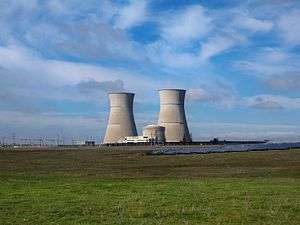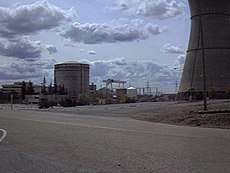Rancho Seco Nuclear Generating Station
The Rancho Seco Nuclear Generating Station is a decommissioned nuclear power plant built by the Sacramento Municipal Utility District (SMUD) in Herald, California.
| Rancho Seco Nuclear Generating Station | |
|---|---|
 | |

| |
| Country | United States |
| Location | Herald, California |
| Coordinates | 38°20′43″N 121°7′18″W |
| Status | Decommissioned |
| Commission date | April 17, 1975 |
| Decommission date | 2009 |
| Construction cost | $375 million in 1974 dollars[1] ($1.52 billion in 2018 dollars[2]) |
| Operator(s) | SMUD 1974-present |
| Nuclear power station | |
| Reactor type | Pressurized water reactor[3] |
| Reactor supplier | Babcock & Wilcox[3] |
| Thermal capacity | 1 x 2772 MWth[3] |
| Power generation | |
| Nameplate capacity | 918[3] |
| Capacity factor | <40%[1] |
| External links | |
| Commons | Related media on Commons |
History
In 1966, SMUD purchased 2,100 acres (850 ha) in southeast Sacramento County for a nuclear power plant, which was built in Herald, 25 miles (40 km) south-east of downtown Sacramento.
In the early 1970s, a small pond was expanded to a 160-acre (65 ha) lake to serve as an emergency backup water supply for the station. The lake has always received its water from the Folsom South Canal and has no relationship with the power plant's daily water supply. Surrounding the lake is 400 acres (160 ha) of recreational area originally operated by the County of Sacramento for day-use activities.
The 2,772 MWt Babcock & Wilcox pressurized water reactor (913 MWe) achieved initial criticality on September 16, 1974 and entered commercial operation on April 17, 1975.[3]
On March 20, 1978, a power supply failure for the plant's non-nuclear instrumentation system led to steam generator dryout (ref NRC LER 312/78-001). This triggered an automatic reactor shutdown. In a 2005 document, the United States Nuclear Regulatory Commission indicated that it was the third most serious safety-related occurrence in the United States to date (behind the Three Mile Island accident and the Browns Ferry cable tray fire).[4][5]
The plant operated from April 1975 to June 1989, but had a lifetime capacity average of only 39%; it was closed by public vote on June 7, 1989 after multiple referenda that resulted from a long record of multiple annual shut-downs, cost over-runs, mismanagement, multiple accidents that included radioactive steam releases, restarts after unresolved automatic shut-downs, and regular rate increases that included a 92% increase over one three-year span.[6]
Operation of the recreational area was assumed by SMUD in 1992. In cooperation with the Nature Conservancy, SMUD dedicated in June 2006 the Howard Ranch Nature Trail, a seven-mile (11 km) long trail that follows riparian and marsh habitat along Rancho Seco Lake and the adjoining Howard Ranch that once belonged to the owner of the famous racehorse Seabiscuit.
All power-generating equipment has been removed from the plant, and the now-empty cooling towers remain a prominent part of the local landscape. Also scattered throughout the area around the plant are abandoned civil defense sirens that at one time would have warned people of a radioactivity release from the station. Additions to SMUD's Rancho Seco property have included massive solar installations and, more recently, the natural gas-fired Cosumnes Power Plant, brought online in 2006.
On October 23, 2009, the Nuclear Regulatory Commission released the majority of the site for unrestricted public use, while approximately 11 acres (4.5 ha) of land including a storage building for low-level radioactive waste and a dry-cask spent fuel storage facility remain under NRC licenses.[7]
The plant cost $375 million[1] when it was built in 1974 ($1.52 billion in 2018 dollars[2]) and it cost about $120 million in 1974 dollars to decommission ($485 million in 2018 dollars[2]), according to the SMUD Rancho Seco Nuclear Education Center.
Gallery
 Rancho Seco nuclear power plant (no longer operating)
Rancho Seco nuclear power plant (no longer operating) Rancho Seco towers
Rancho Seco towers The containment building with a part of the cooling tower
The containment building with a part of the cooling tower One of the two cooling towers, showing the base
One of the two cooling towers, showing the base
See also
- Rancho Seco Recreational Park
- S. David Freeman, former SMUD leader, notable for his involvement in the decommissioning of the plant.
| Wikimedia Commons has media related to Rancho Seco Nuclear Generating Station. |
References
- Wald, Matthew L. (1989-06-08). "Voters, in a First, Shut Down Nuclear Reactor". The New York Times. ISSN 0362-4331. Archived from the original on 2015-05-25. Retrieved 2016-07-09.
- Thomas, Ryland; Williamson, Samuel H. (2019). "What Was the U.S. GDP Then?". MeasuringWorth. Retrieved April 6, 2019. United States Gross Domestic Product deflator figures follow the Measuring Worth series.
- "NRC: Generic Environmental Impact Statement for License Renewal of Nuclear Plants: Appendices (NUREG-1437, Volume 2)". www.nrc.gov. Retrieved 2020-01-03.
- "Policy Issue Information". United States NRC.
- "Attachment 2 Policy Issue Information" (PDF). U.S. Nuclear Regulatory Commission. Archived (PDF) from the original on 20 October 2008. Retrieved 30 August 2010.
When the reactor was at power, a failure of the NNI power supply resulted in a loss of main feedwater, which caused a reactor trip. Because instrumentation drift falsely indicated that the steam generator contained enough water, control room operators did not take prompt action to open the EFW flow control valves to establish secondary heat removal. This resulted in steam generator dryout. LER 312/78-001
- http://www.energy-net.org/01NUKE/RSECOT.HTM
- "Rancho Seco nuclear power plant ends decommissioning". Power Engineering. PennWell. 2009-10-26. Retrieved 2009-10-30.